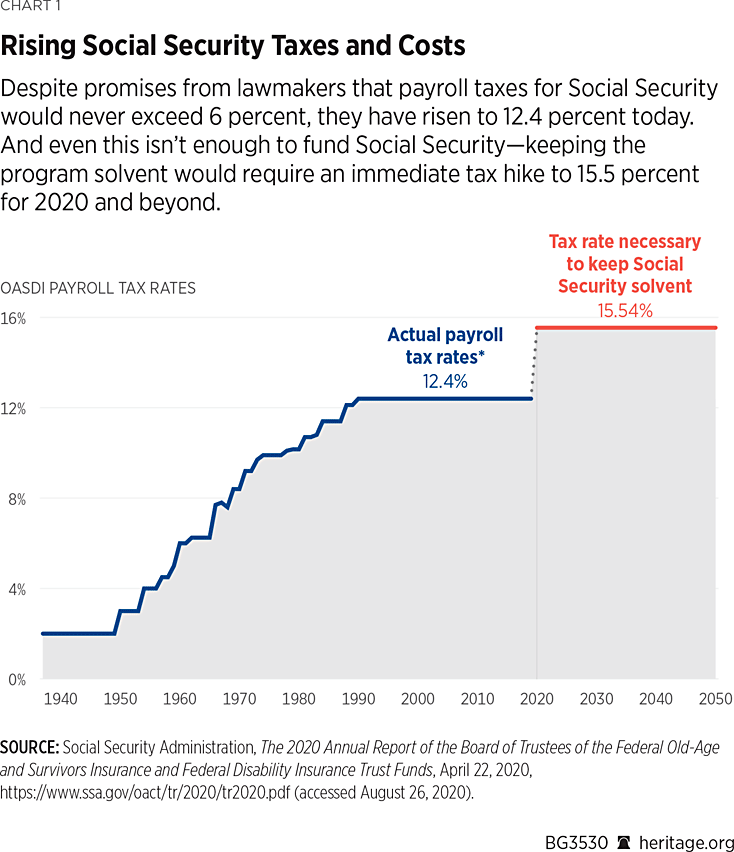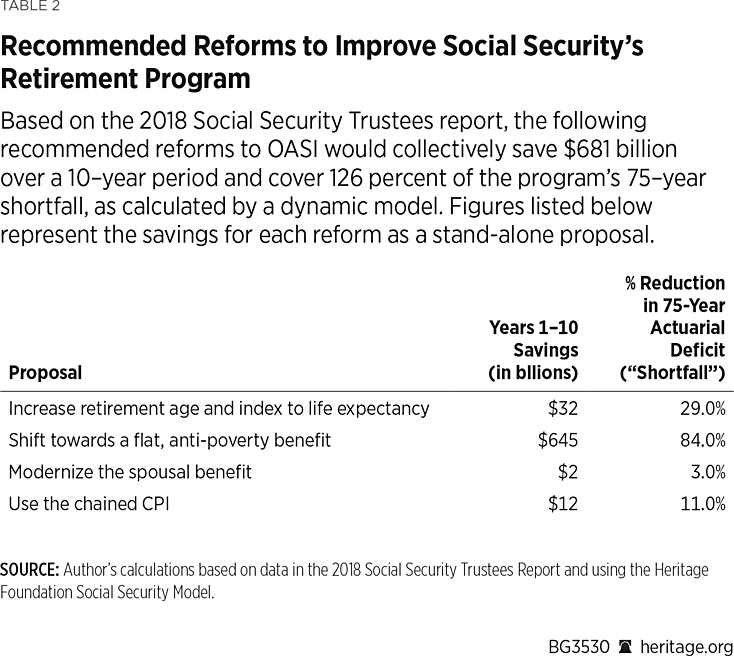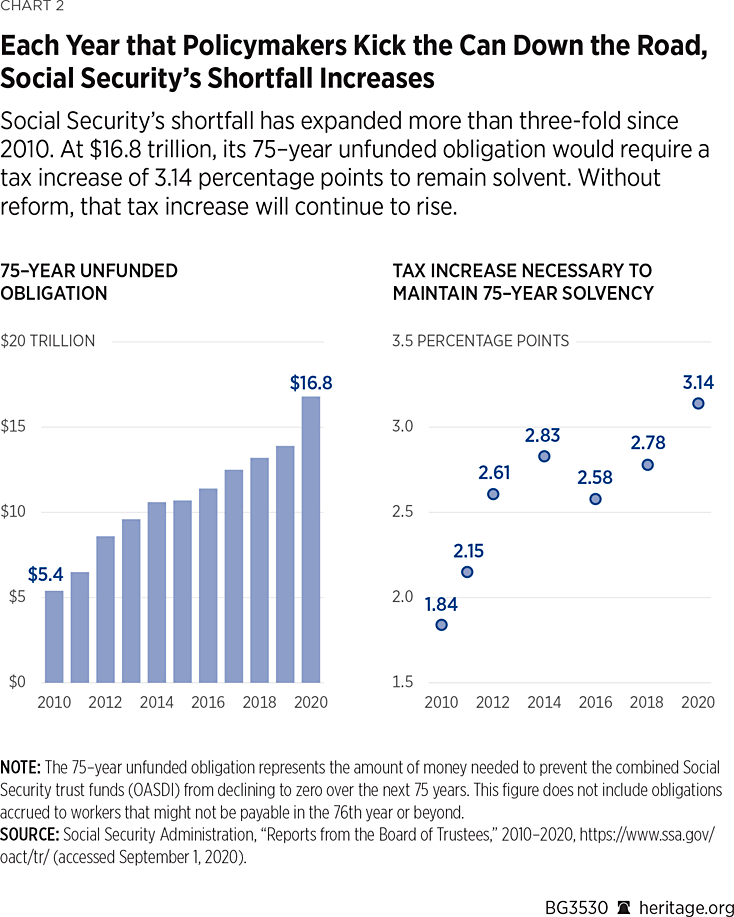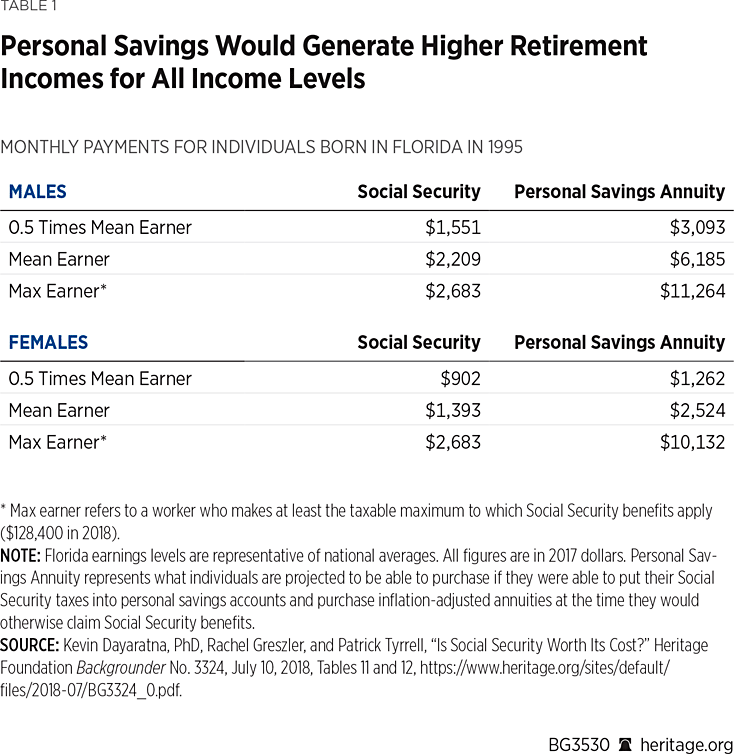President Donald Trump’s executive order allowing a deferral of workers’ Social Security payroll taxes between September 2020 and December 2020, to be paid in the future, will have only a tiny, if any, impact on Social Security’s finances. Even if the next Administration and Congress were to convert the deferral into a payroll tax holiday by forgiving deferred taxes, policymakers would almost certainly hold Social Security harmless by using general revenues to replace lost Social Security taxes, as they have in similar instances in the past.
Financing a payroll tax holiday with general revenues could add as much as $149 billion to the U.S. debt, however. Now is a time to focus on the coronavirus pandemic and on getting Americans back to work safely. Boosting the incomes of individuals who still have jobs, and who are likely to save much of that income, is not an effective use of future taxpayers’ dollars.
The economic consequences of COVID-19 have exacerbated Social Security’s shortfalls, while also drawing the program’s flaws to light as Social Security’s significant tax burden makes it harder for individuals to accumulate savings. While deficit-financed payroll tax cuts would not be an effective way to boost the economy, it is possible to reduce payroll taxes over the long run while also making Social Security solvent. A smaller, more targeted Social Security program would restore confidence in the U.S. economy and give Americans more control over their finances today and in the future.
What the Executive Order on Payroll Tax Deferrals Allows
On August 8, 2020, President Trump issued a series of Executive Orders aimed at addressing the economic consequences of the COVID-19 pandemic. One orderREF directs the Secretary of the Treasury “to defer the withholding, deposit, and payment” of the employee portion (6.2 percent) of the 12.4 percent Social Security payroll tax between September 1, 2020, and December 31, 2020.REF The Administration later clarified that the order was optional for employers, so it is yet unknown how many employers will defer their employees’ payroll taxes and whether they will give their workers’ a choice.
For someone making $60,000 a year, this provision would allow $1,240 in payroll taxes that would otherwise be withheld and credited to the Social Security trust funds to be included in that worker’s paychecks between September 1 and December 31. Those deferred taxes will be due during the period of January 1, 2021, and April 30, 2021, and it appears that businesses that choose to defer employees’ taxes will be responsible for later collecting and submitting those taxes to the IRS.REF
Tax Deferral Will Not Significantly Affect Social Security’s Sustainability
Many Americans—older ones, in particular—are concerned about the effects of a payroll tax deferral on Social Security’s viability. They can rest assured, the deferral will have only a tiny impact, if any, on Social Security’s finances. I estimate that, if all employers and all self-employed individuals opt to defer eligible employees’ payroll taxes (an unlikely occurrence representing the upper bound), the Social Security trust funds could experience up to $131 billion in deferred tax revenues.REF In order to keep making benefit payments, the Treasury Department will have to substitute deferred revenues by cashing in on an equal amount of Social Security’s trust fund IOUs earlier than planned.REF The lost revenues would later be replaced once deferred payments come due. That temporary shift would cause Social Security’s trust fund to accumulate an estimated $778 million less in interest payments.REF Social Security currently sends out about $90 billion in benefits each month, so a potential $778 million loss would shorten Social Security’s solvency by about six hours.REF
Since trust fund interest payments are essentially the government paying itself interest—a transfer of general revenues into the trust funds—interest lost by the trust funds would be interest saved by general revenues, resulting in zero deficit impact and a very slight hastening of Social Security’s insolvency.
Potential Payroll Tax Holiday Also Unlikely to Affect Social Security’s Sustainability
The Administration does not have the authority to grant a payroll tax holiday, but President Trump stated his intentions to convert the deferral into a “payroll tax holiday” if he is re-elected. In a press briefing on August 12, President Trump stated: “When I win the election I am going to completely and totally forgive all deferred payroll taxes, without in any way, shape, or form hurting Social Security.”REF
President Trump went on to explain: “That money is going to come from the general fund. We’re not going to touch Social Security. I said from day one that we are going to protect Social Security.”REF
This transfer of revenues from the general fund to Social Security is what Congress did in 2011 and 2012. Following a two-year two percentage point reduction in the payroll tax, Congress provided $217 billion in general fund transfers to the Social Security trust funds to replace their lost revenues.REF
But, Payroll Tax Holiday Would Almost Certainly Drive Up U.S. Debt
Assuming that a payroll tax holiday would be accompanied by replacement of those lost payroll tax revenues with general revenues, this would increase the U.S. publicly held debt. The potential cost of a payroll tax holiday depends on how many employers opt into deferring the payroll tax and whether workers who do not have their payroll taxes deferred will receive cash payments equal to the taxes that could have been deferred. For example, if a worker’s employer did not defer his taxes, but he was eligible to defer $1,500 in taxes, would policymakers authorize payments—$1,500 in this case—to workers who “missed out” on the deferral-turned-holiday?
Assuming the maximum cost—with all eligible workers receiving the maximum deferral forgiveness or equivalent subsequent payment—I estimate that a four-month payroll tax holiday from September through December 2020 would cost up to $131 billion in lost revenues.REF Including 10-year interest costs, a four-month payroll tax holiday for workers making less than $104,000 could cost up to $149 billion.REF Since not all employers and individuals will defer taxes, the actual cost of a payroll tax deferral-turned-holiday would be lower unless policymakers also provided direct payments to those who did not defer taxes.
Social Security Has Long Been Insolvent, COVID-19 Exacerbates Its Future
Social Security was on track to become insolvent long before COVID-19. In fact, a mere five years after the major 1983 Social Security reforms that were supposed to keep the program solvent through at least 2058, the program’s trustees projected that it would instead become insolvent 10 years sooner, in 2048. Since then, Social Security’s finances have further deteriorated. The 2020 Social Security trustees’ report projects that the program will become insolvent and able to pay only 79 percent of scheduled benefits beginning in 2035.REF That does not include the effects of COVID-19.
The Great Recession had the effect of quickening the anticipated date of Social Security’s trust fund exhaustion by nine years.REF While is it unlikely that the COVID-19 recession will have as large of an effect on Social Security’s finances, it will hurt Social Security’s sustainability. According to initial estimates from the Social Security trustees, the Bipartisan Policy Center, the Penn Wharton Budget Model,REF the Congressional Budget Office, and the Committee for a Responsible Budget, the COVID-19 recession is expected to hasten Social Security’s insolvency by one to six years (to between 2029 and 2034), or potentially longer if the recession lasts longer than anticipated.REF
COVID-19 Focused a Spotlight on Social Security’s Flaws
Despite its financial consequences, COVID-19 has not altered Social Security’s fundamental flaws, but rather drawn them to the light. Many Americans lack the savings that could have helped them to better weather the pandemic. At least in part, that is because Social Security consumes so much of workers’ paychecks that it can be hard to save for a rainy day, and even more difficult to save and pay for major life events like buying a home and the big costs involved with raising children, such as childcare and education. By locking up workers’ money until a specified date, Social Security can also unfairly restrict the lifetime incomes of workers who die early and prevent them from passing their money on to their families. (This disproportionately affects lower-income and minority workers who tend to have lower life expectancies.)
These downfalls were not envisioned by Social Security’s founders, but they are a consequence of Social Security expanding far beyond its original intent. When Social Security first began, it took just 2 percent of workers’ paychecks, and promised to never take more than 6 percent. Today, it takes 12.4 percent—and even that is far short of the 15.5 percent needed to pay scheduled benefits. Consequently, Americans have grown disturbingly dependent on an insolvent government program for their retirement, while having smaller after-tax paychecks and less control over their finances and life decisions.

One of the biggest advantages of Social Security is that it is supposed to provide guaranteed benefits; but what was once considered a sure thing is increasingly uncertain. In fact, for anyone under the age of 47, the only guarantee is that Social Security cannot provide its scheduled benefits. Even people already retired and receiving Social Security could have their benefits cut within 10 years to 15 years. Not surprisingly, more than 80 percent of Generation X and Millennials are concerned that Social Security will not be there for them when they retire.REF
And yet, Social Security is limiting workers’ ability to make up for potential lost Social Security benefits because workers are forced to put 12.4 percent of their paychecks into a program that strips them of the opportunity to earn a positive rate of return over time. Since 2010, every dollar that workers contribute in payroll taxes has gone straight out the door to pay retirees’ benefits. This is unfair to current workers and unhelpful to the American economy because shifting incomes from younger to older generations displaces savings, reduces productivity and output, and results in smaller incomes for younger and future workers. According to Heritage Foundation analysts, this lack of investment opportunity on Social Security taxes will strip $4,320 worth of retirement income per year from someone who makes about $20,000, while extracting $47,712 per year of potential retirement income from someone who makes about $60,000 per year.REF
How to Preserve Social Security, Target Benefits, Increase Incomes, and Promote Wealth
Policymakers face straightforward choices on how to address Social Security’s looming insolvency. They can make Social Security bigger by raising taxes and increasing benefits, or they can make it smaller by better targeting benefits and reducing everyone’s taxes.
An example of the bigger solution is the Social Security 2100 Act,REF which would make the program solvent by gradually raising Social Security’s tax from 12.4 percent to 14.8 percent, while also increasing benefits for everyone. Under the Social Security 2100 Act, someone who earned $1,000,000 per year while working would, in retirement, receive an extra $1,028 per month from Social Security while someone who earns $30,000 per year would get an extra $28 per month.REF
In contrast, Heritage Foundation analysts have a proposal to make Social Security smaller and better targeted to those in need. This proposal would gradually shift the program to provide a flat benefit by reducing benefits for middle-income and upper-income earners and increasing them for lower-income earners. Coupled with increasing and indexing Social Security’s eligibility age to life expectancy, using a more accurate measure of inflation, and modernizing the spousal benefit, Heritage analysts estimate that these reforms would fully solve Social Security’s shortfalls and even allow policymakers to reduce Social Security’s payroll tax to 10.1 percent.REF This would translate into higher incomes, greater ability for households to balance their finances throughout their lifetimes, and a probable increase in savings and investment that would spur increased productivity and higher incomes.

Analyses from the Penn Wharton Budget Model show that a smaller Social Security program would have positive impacts across the economy, leading to a 5.3 percent increase in gross domestic product (GDP) in 2049.REF In contrast, the model projected that a larger Social Security program as envisioned under the Social Security 2100 Act would have an increasingly negative effect on the economy, reducing GDP by 2.0 percent in 2049.REF As former Social Security Principal Deputy Commissioner Andrew Biggs explains: “The logic is straightforward: When taxes go up people work less; when Social Security benefits go up, people save less. If people work less and save less, the economy grows more slowly.”REF
Social Security is in desperate need of reform, and each year that Congress fails to address the program’s shortfalls exacerbates Social Security’s deficits and the magnitude of necessary reforms. Between 2019 and 2020 alone—and not accounting for any effects of COVID-19—Social Security’s 75-year shortfall increased by $2.9 trillion to $16.8 trillion—a 21 percent increase in just a single year.REF Between 2010 and 2020, Social Security’s 75-year shortfall more than tripled, from $5.4 trillion to $16.8 trillion, and the amount by which payroll taxes would have to increase to ensure 75 years of solvency is now 70 percent higher than in 2010. Today, a 3.14 percentage point increase (to 15.54 percent) would be necessary, while a 1.84 percentage point increase (to 14.24 percent) would have been enough in 2010.REF One can expect even greater shortfalls in the Social Security trustees’ 2021 report.

Social Security, as current retirees and past generations have experienced it, is simply not possible for current workers and future generations. The program’s enormous unfunded obligations mean that younger generations will have to bear part of the burden of the program’s previous excesses. How much they will bear, however, will directly align with Social Security’s size and scope—a bigger program will take more in taxes and limit households’ control over their lifetime finances, while a smaller program will reduce taxes and give households more options to make lifetime choices that align with their unique circumstances and goals. Moreover, by shifting part of workers’ tax dollars away from Social Security’s pay-as-you-go structure to one that allows individuals to earn a positive rate of return over time (a return that reflects actual productivity growth from investments as opposed to extracted income from younger workers), all Americans could benefit from productivity and income gains. It is also likely that such a shift—particularly if accompanied by an option for workers to put part of their payroll taxes into personal accounts—would reduce income inequality and wealth inequality in the U.S.
Conclusion
The recent Executive Order allowing a deferral of workers’ Social Security payroll taxes between September and December 2020 could reduce Social Security’s interest revenues by $778 million—the equivalent of about six hours’ worth of Social Security’s expenses. Congress could decide to replace this lost interest with general revenues.
If the next Congress turns the payroll tax deferral into a payroll tax holiday, it is still highly likely that policymakers would hold Social Security harmless through a general revenue transfer. Such a move would, however, increase the federal debt by up to $149 billion over the next 10 years.
At $26 trillion-and-rising, the national debt already amounts to about $207,000 per household. Considering that personal disposable incomes actually increased by $1.5 trillionREF and personal savings surged to $4.7 trillionREF in the second quarter of 2020 (meaning many people already received an income boost and are saving, instead of spending, it), temporarily reducing taxes for the 147 millionREF Americans who still have jobs would not be an effective use of future taxpayers’ dollars.
Social Security was on the path to insolvency long before COVID-19. Although the pandemic has exacerbated Social Security’s shortfalls, it has not altered the program’s fundamental flaws. Deficit-financed payroll tax cuts would not be an effective way to boost the economy, but reforming Social Security to make it smaller, better targeted, and viable for the long run would restore confidence in the U.S. economy and put Americans on a more sound financial footing for the future. Despite enormous unfunded liabilities, it is actually possible to make Social Security solvent, increase benefits for lower-income workers, and return more income and greater control to individuals. Doing so should be a priority for the next Administration and the 117th Congress.
Rachel Greszler is Research Fellow in Economics, Budgets, and Entitlements in the Grover M. Hermann Center for the Federal Budget, of the Institute for Economic Freedom, at The Heritage Foundation.




